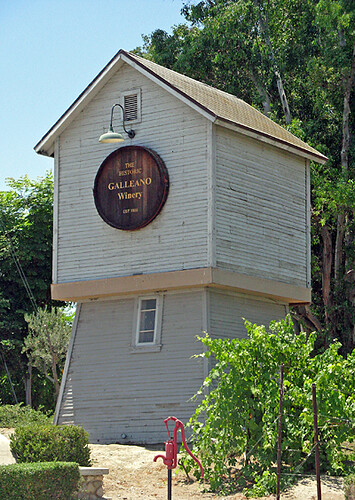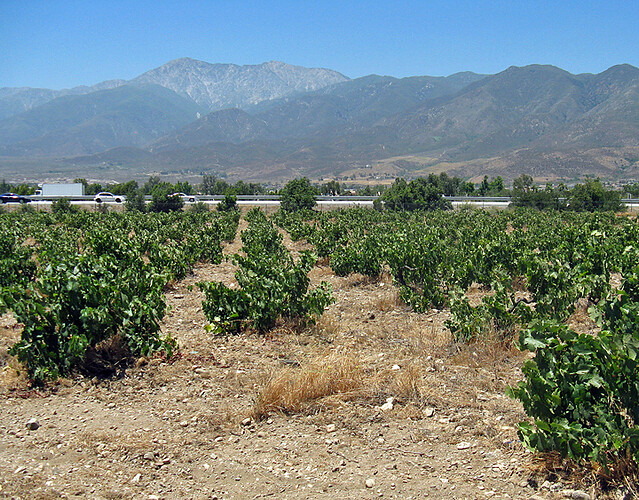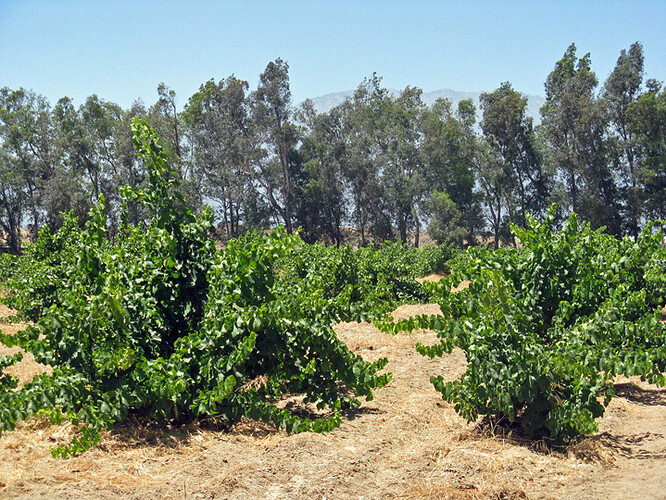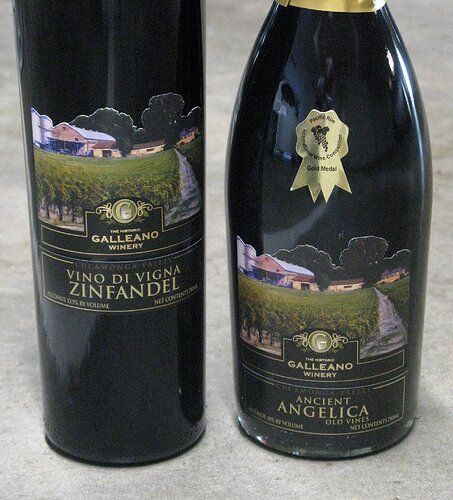Southern California Wine Tour – June 2018, Part 4B – Cucamonga Valley
I’ve posted a portion of a report on a late-June wine trip to Southern California wine country – San Diego County, Temecula Valley, and Cucamonga Valley. The report has been split into four parts, and the portion below is from Part 4 of 4. I split Part 4 into two segments for posting here since each segment is from a very different wine region in Southern California, and this is the second of those two and the final segment from the wine trip. The full reports for each day of the trip can be found on the Grape-Nutz.com website – here’s the link for Part 4:
Southern California Wine Tour – June 2018 – Part 4
Galleano Winery
Eric, Jay, Paul, Barry, and I had visited wineries in San Diego County and Temecula Valley on the first three days of our Southern California wine tour. Despite their proximity, the two regions are very different in many ways, but we found good wines in both of them. Tuesday was the final day of our tour, and it would include a visit to one of Southern California wine country’s newest producers as well as one of its oldest.
After our Tuesday morning visit to new vineyards being developed in the De Luz area of Temecula, I talked with Eric, Jay, Paul, and Barry, and they decided not to join me on my afternoon visit to Cucamonga Valley – it would have been something of a detour for all of them and I can’t blame them for not wanting to fight the traffic in that area. The four of them had lunch in Temecula and then went home to Orange County, where they all got back to their respective places by mid-afternoon. I drove north to Cucamonga Valley (no time for lunch on this day for me, oh well), and I arrived a little after 12:30 at my winery destination there.
Before proceeding to the winery visit, here’s a short introduction to Cucamonga Valley.
Cucamonga Valley
Cucamonga Valley is located between Los Angeles and San Bernardino, near the foot of the San Gabriel Mountains. Early commercial winegrape planting was established by Tiburcio Tapia in 1838 and grew from there. A portion of his winery still stands and is thought to be the oldest winery building in California. Although grapevine cultivation and wine production declined throughout most of Southern California in the later nineteenth century, it continued to thrive in Cucamonga Valley. Secondo Guasti’s Italian Vineyard Company vineyard encompassed over 20,000 acres by the 1910s, reputedly the world’s largest at that time. At the beginning of Prohibition, more winegrapes were grown in Cucamonga Valley than in Napa and Sonoma combined. Even Prohibition didn’t hurt the region’s vineyards substantially, as growers provided fruit for sacramental wines and shipped boxes of grapes – mostly Zinfandel – to home winemakers throughout the country.
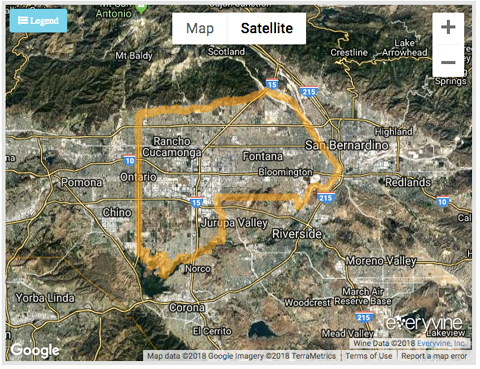
Image credit: everyvine.com
Following Prohibition, more wineries were launched in Cucamonga Valley and by 1940 there were more than 45,000 acres of vineyards and around 60 wineries in the region. But following World War II, Cucamonga Valley faced increasing pressure from development, as the greater Los Angeles urban area spread over more and more land. Brookside Winery was the largest in Cucamonga Valley for a number of years, but it faded away by the early 1980s. The Cucamonga Valley AVA was established in 1995, but it has not helped much with the continued decline of the region’s wine industry. Today there are probably fewer than 1,000 acres of vineyard remaining in Cucamonga Valley, and only three wineries – Galleano, Joseph Filippi, and tiny Rancho de Philo – continue to produce wine in the region. The focus of all three is probably much the same as 50-60 years ago, with sweet, fortified wines being a particular specialty. In addition to these three Cucamonga Valley producers, several vintners from outside the region have bought fruit from there.
The climate of Cucamonga Valley is quite warm and is prone to significant winds, and the soils are alluvial, with lots of deep sand and some rocky areas. Not surprisingly, grape varieties that do well in warmer climates are the predominant ones in the region, including Zinfandel and Grenache. Since many of the remaining vineyards were planted before World War II, a number of older varieties rarely seen in more modern California vineyards still thrive in Cucamonga Valley, including Mission, Palomino, Golden Chasselas, as well as more familiar varieties such as Alicante Bouschet, Carignane, Cinsault, and Mataro.
Galleano Winery
My final visit of the Southern California wine tour was at Galleano Winery in the historic growing region of Cucamonga Valley. Located in the Mira Loma area at the northern edge of Riverside County, the winery and adjacent vineyard are like an oasis in a landscape dominated by anonymous warehouses and business parks – a far cry from past years when this was all a thriving grape-growing area. There are fewer than a handful of wineries remaining in Cucamonga Valley now, and since I knew I would only have time to visit one of them, Galleano was my choice. This was due both to its long history and also because the Galleano family manages the region’s best-known old vines at Lopez Vineyard, which I hoped to see while I was in the area. I’d tried a Lopez Vineyard Zinfandel made by Carol Shelton at a tasting a few months before my visit and found both the wine and the story behind it to be intriguing.
The day was already getting hot when I arrived at the winery tasting room in the early afternoon. I was a bit earlier than expected and had to wait for a few minutes for Domenic Galleano to arrive, so Jorge Davalos at the tasting room poured me a few tastes to start off. The simple, rustic tasting room and the old winery buildings all have a real throwback feel to them, as if you could have walked in 50 years ago and it would have felt exactly the same. Jorge told me he had worked at Galleano for 11 years, and I soon found that some employees there have been with the winery for decades. Domenic came into the tasting room after a short time and greeted me.
Domenic told me that Galleano is the oldest winery in Southern California that is still run by the original founding family and in its original location. Much of the winery production is in Sherry and Port style wines – styles that were once common throughout many California wine regions but which have fallen out of favor in all but a few. The wineries of Cucamonga Valley continue to specialize in these sweet wines.
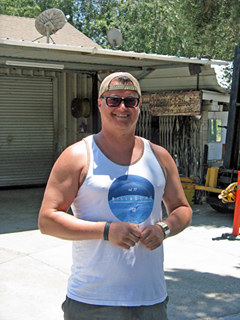
Domenic Galleano
Galleano Winery’s history stretches back to 1927, when Domenico Galleano, who had arrived in California from the Piemonte region of Italy in 1913, purchased the 160-acre Cantu Ranch in the community of Wineville – the area had been well-known for vineyards prior to Prohibition. A few years later the town was renamed Mira Loma, though the road where the current winery is located is still called Wineville Road. When Prohibition ended in 1933, Galleano Winery officially started production – though Domenico may well have been making wine there even before the end of Prohibition! For some time, an older building on the property was used as the winery until the current winery structure was built in the late 1940s. The complex of old structures at the Cantu-Galleano Ranch is now listed on the National Register of Historic Places. In 1983 Domenico’s grandson Don and Don’s wife Charlene took over the operation of the winery, and they have been joined by their son Domenic in running the business.
Domenic asked me if I would like to take a brief tour of the winery, and I couldn’t pass up an opportunity to take a look at an older facility such as this one. Another tasting room visitor and I followed Domenic back into the main winery structure, where he showed us a row of huge (10,410 gallon capacity) old concrete fermentation tanks that are still used for most of Galleano’s red wine production. Concrete is again becoming a favored fermentation vessel among smaller wineries – Domenic joked about Galleano that “we’re so old, we’re new again”! Equally impressive were the enormous (15,700 gallon) 70-year old redwood upright tanks used for aging red wines.
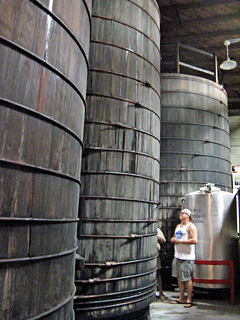
Heading outside behind the winery building, Domenic showed us the temperature-controlled stainless steel tanks used for white wine production, and the old press and destemmer, which still work well. From there, we could see Galleano’s old seven-acre vineyard adjacent to the winery, that includes Palomino, Golden Chasselas, Grenache, Zinfandel, Mission, Alicante Bouschet, and Cinsault vines, planted in the 1940s and all head-trained and dry-farmed. The family manages other vineyards in Cucamonga Valley, including Lopez Vineyard.
Domenic knew that I wanted to see Lopez Vineyard, and since he had other business that he needed to attend to, he turned me over to Alfredo Arredondo to drive me out to the vineyard. Alfredo has worked for Galleano Winery for 43 years, and does mostly winery and vineyard maintenance work. I hopped into his pickup truck and we headed out to the vineyard, located about eight miles north of the winery and near the foot of the San Gabriel Mountains, close to the junction of the Interstate 210 and Interstate 15 freeways in Fontana. With traffic, it took a little while to get to the vineyard but I enjoyed talking with Alfredo as we made our way to the site.
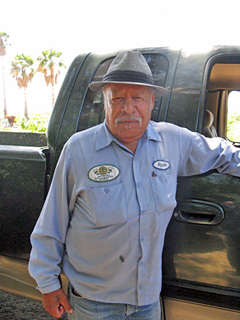
Alfredo Arredondo
Lopez Vineyard was planted in 1918 and is about 350 acres in size, by far the largest vineyard remaining in Cucamonga Valley and perhaps the oldest. Alfredo told me that there are about six acres of Grenache with the rest of the vineyard planted to Zinfandel. The vines at Lopez are all own-rooted, head-trained, and dry-farmed, which Alfredo said is typical of vineyards in the area. Lopez Vineyard is also farmed organically. The soil is sandy and rather rocky, and the vines are surprisingly tiny given their age. No big gnarly vine trunks here – the vines are no more than 24-30 inches tall, possibly due to the limited water and nutrients available to them. The roots are said to extend as far as 30-50 feet into the ground. Harvest at Lopez Vineyard typically starts around mid-August, and can last several weeks. Not surprisingly, the crop yield from such tiny vines is small, though Alfredo said that the harvest from there in 2017 was a particularly big one for the site, at around 300 tons – he thinks the crop will be smaller this year.
Lopez Vineyard
As we left Lopez Vineyard, Alfredo asked whether I’d like to take a look at another old vineyard on our way back to the winery – of course I would! Along the way, we passed what looked to be a large field of neglected old vines and Alfredo told me that this was Gateway Vineyard. Galleano brought in the last harvest from there in 2017 and it sounds like the 20+ acres of Zinfandel vines, probably planted in the 1930s, will be pulled out and the land developed for warehouses and two hotels.
We drove past Ontario Airport and soon afterwards came to our destination at Hofer Ranch. Founded in 1888 and listed as a National Historic Register Property, it’s now owned by Paul Hofer III, a descendent of original owner Sanford Ballou. Alfredo and I got out of the truck and walked along the sandy soil to check out the old own-rooted Grenache vines there, much larger than the Zin at Lopez and with lots of fruit on the vines. The vineyard had once been much larger and had included Mission vines, but only six acres of Grenache now grows there. It’s uncertain when these head-trained and dry-farmed vines were planted – possibly in the early 1930s though some could be as old as the late nineteenth century.
Hofer Ranch
When Alfredo and I got back to the winery, he saw that Don Galleano was home and he introduced me to Don. It would have been interesting to hear some of Don’s stories about the past of the winery and the area’s vineyards but he was on his way to a meeting. Stopping back at the tasting room, Domenic poured a few other wines for me before he also needed to leave.
The first two Galleano wines I tasted with Jorge were a white and a red. The NV “Cucamonga Peak” White had upfront stone fruit and tropical fruit aromas with floral notes, lighter-bodied with an off-dry finish – a basic, pleasant summertime sipper. I also tasted the NV Hofer Ranch “August” Grenache, a rosé produced from the old vines I saw that afternoon. This featured ripe cherry, spice, and a touch of oak, with medium-light weight and a slightly sweet finish.
Domenic poured three of the four Galleano Zinfandels for me, starting with the NV “House” Zinfandel, a spicy and lighter-bodied Zin with milder tannins and a hint of sweetness, nothing fancy but a bargain at less than $10 for a solid wine in this style. The NV “Pioneers Legendary” Zinfandel, sourced from Lopez Ranch, was a clear step up, displaying more intense wild berry fruit, spice, and hints of pepper, medium-bodied with moderate tannins on the lively, dry finish. Even better was the NV “Vino de Vigna” Zinfandel – also sourced from Lopez Ranch, this was a bolder yet balanced Zin, with berry, spice, pepper, savory herbs, and a hint of sweet oak, a slightly richer mouthfeel than the previous wine, and fine tannins on the finish.
I finished my tasting with Domenic with three sweet wines. The first was the NV “Mary Margaret” Sherry, named for Mary Margaret Galleano, Don Galleano’s mother who passed away in 1997. This was a standout, with apricot, pecan, honey, and caramel aromas, a rich yet lively mouthfeel, and a long, sweet finish. The NV “Three Friends” Port is Zinfandel-based, and also includes Alicante Bouschet, Cinsault, and Mourvèdre. A tawny-style Port, this had upfront aromas of raisin, brown sugar, spice, and nut, a mouth-coating texture and very sweet finish. The final wine was the NV Angelica, made in the traditional old California style from old-vine Mission fruit. Galleano uses a sort of solera system for barrel-aging the Angelica, and Domenic told me that the current release is mostly from 2003 vintage fruit. The wine had aromas of chocolate, spice, and pecans, with rich, sweet flavors and finish.
Galleano produces several additional table wines and sweet wines made from Cucamonga Valley fruit, and also sells some Central Coast wines through a partnership with Tarrica Wine Cellars in Paso Robles (Chardonnay, Pinot Gris, Riesling, Cabernet Sauvignon, Petite Sirah). The winery’s specialties are its old-vine Cucamonga Valley Zinfandels and – as mentioned briefly above – its Sherry and Port style sweet wines. Total production is about 30,000 cases per year, and all of their bottled wines are sold direct to consumer.
My visit to Galleano was one of the most memorable stops for me on this Southern California wine tour. It was a real step back into California’s wine past, both in terms of the winery and tasting room and also for the wines themselves. Few California wineries continue to produce the kinds of wines that are Galleano’s strength, particularly its array of sweet wines. Domenic was a great host, and both Jorge and Alfredo were knowledgeable and entertaining. My favorite wines from the tasting were the “Vino di Vigna” Zinfandel and the “Mary Margaret” Sherry, and I also enjoyed the “Pioneers Legendary” Zinfandel and the Angelica. The Galleano wine family spans five generations now, and I got the sense that there are no plans to change what has been successful for them for so many years. I should note that prices at Galleano are old-school as well as everything else about the winery. This is a place that anyone with a serious interest in the history of California wine should visit. For a unique look into the past of California wine – as well as for some solid bottlings at great prices – you’ll find few places that offer the experience that Galleano does.
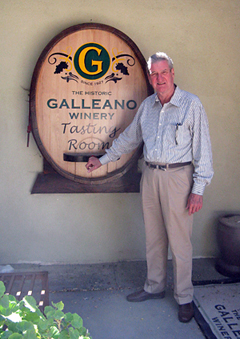
Don Galleano
